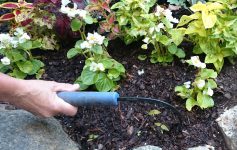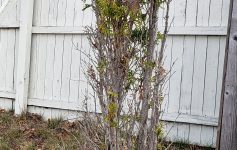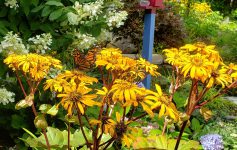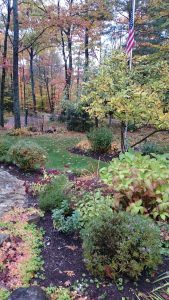
Once the garden season begins to wind down, some gardeners feel their seasonal work is done. Pumpkins, apple picking and leaf peeping give rise to more leisurely autumn activities. But the sustainable gardener knows how very important this time of year can be for next season’s performance.
If you want a better garden next season, devote some time to clean up and prepping your beds NOW! First and foremost, remove the leaves and debris from your areas. Some folks believe the layers of leaves serve to protect and compost their gardens…so they just allow them to pile into the beds and lay there all winter. WRONG! Whole leaves are not beneficial to your bedding areas. In fact, you will see the development of mold and mildew in the areas after only a few days of allowing the leaves to remain in your beds. This week’s rain and warmer temperatures will breed that process. Take a look under those fallen leaves in your beds it is already there! Clean those leaves out! And be sure to remove the remaining weeds from your beds in the process. Yes, many weeds are of an annual nature…but the multitude of seeds produced from that single weed during the fall, will be your garden nemesis next spring.
Getting rid of the leaves will also reduce the occurrence of diseases you may have noted on your plants this past season. August heat and humidity tends to breed this nuisance so getting rid of that damaged material is always good practice.
As growth slows down or stops during the autumn months, there is also the thought that fertilizer is no longer needed. Again WRONG. Applying slow release fertilizers that release their nutrients slowly over many months helps ensure that they will be available to your plants next spring. Choosing the correct fertilizer is important. You will note three numbers on the bag representing N-P-K. The first is nitrogen, the second is phosphorous, and the third, potassium.
Although you don’t see a lot going on with the plant above ground, below the surface, roots are growing. Therefore you want to encourage roots so look for a higher P number, phosphorus. A higher K or potassium number will also encourage cell function and plant growth. Look for a low first number, nitrogen. This will be used to decompose organic matter in your soil over the dormancy months. This year I am using an all organic 3-4-4 combination, a change from my 2-2-2…so let’s see what that brings.
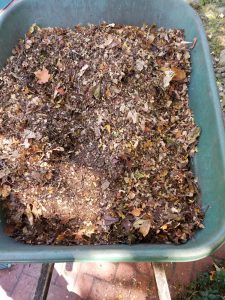 Adding raw materials to your soil this this time of year is also good practice. SHREDDED leaves taken from your mower bag is an inexpensive source. Mixing this into the top layer of your existing soil/organic mulch along with your fall fertilizer will improve your soil. It will make a huge difference in the garden’s ability to retail moisture, encourage healthy plant growth, and minimize other garden stresses.
Adding raw materials to your soil this this time of year is also good practice. SHREDDED leaves taken from your mower bag is an inexpensive source. Mixing this into the top layer of your existing soil/organic mulch along with your fall fertilizer will improve your soil. It will make a huge difference in the garden’s ability to retail moisture, encourage healthy plant growth, and minimize other garden stresses.
Preparing your gardens for our long North Country Winter with just a few steps to improve the soil, will be well worth your time, especially when you see that spring and summer outcome in 2017. So get off the lounge chair, put down the hot cider and get busy preparing for next garden season! As always keeping common sense and sustainability in garden practices!

